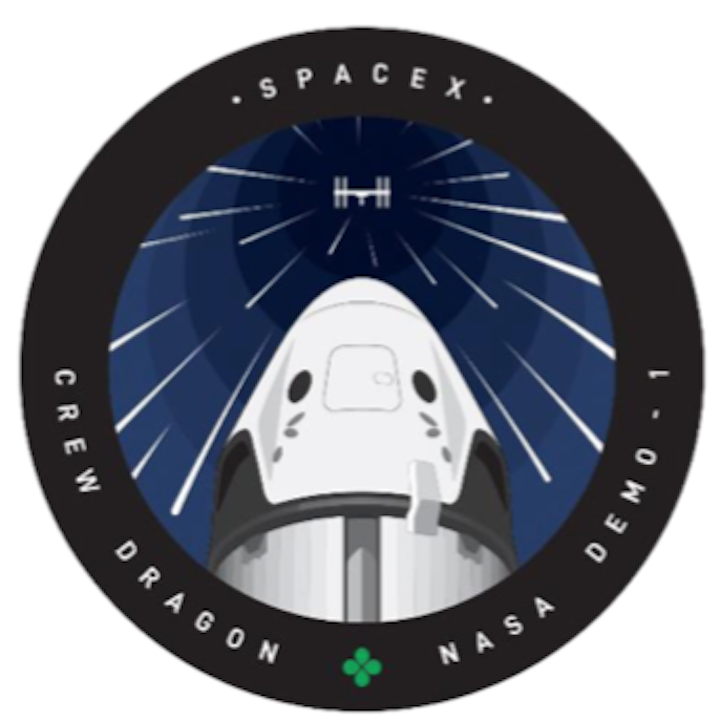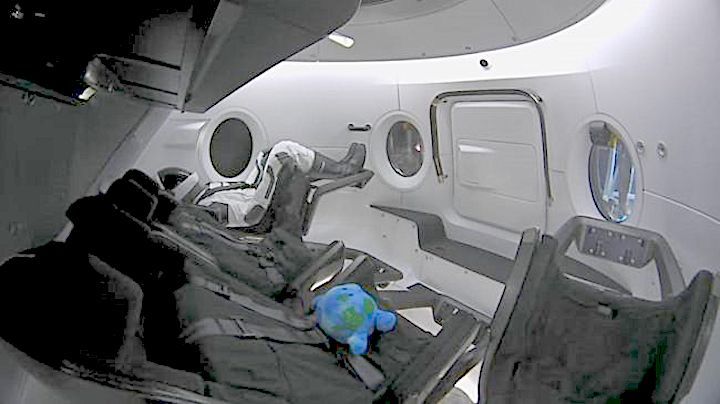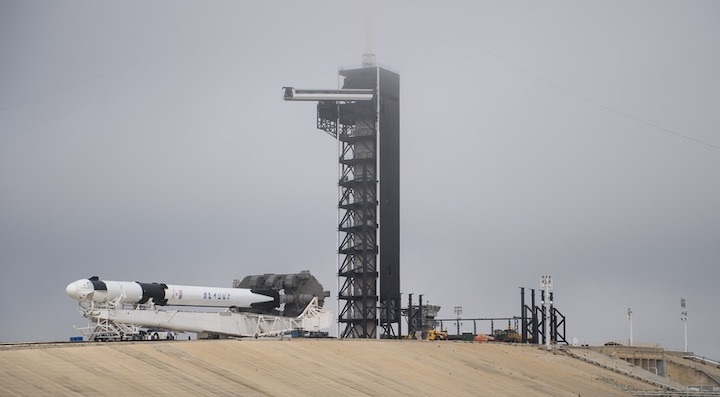3.03.2019

SpaceX closes in on human spaceflight with this weekend's debut of a new capsule designed for astronauts.
The six-day test flight will be real in every regard, beginning with a Florida liftoff Saturday and a docking the next day with the International Space Station. But the Dragon capsule won't carry humans, rather a test dummy — named Ripley after the tough heroine in the "Alien" films — in the same white SpaceX spacesuit that astronauts will wear.
NASA doesn't expect this crucial shakedown cruise to go perfectly. But the lessons learned should improve safety when two NASA astronauts strap into a Dragon as early as July.
"Giant leaps are made by a series of consistent smaller steps. This one will be a big step!" retired astronaut Scott Kelly, NASA's former one-year space station resident, tweeted Thursday.
Boeing is also in the race to end NASA's eight-year drought of launching U.S. astronauts on U.S. rockets from U.S. soil. The space agency is turning to private taxi rides to reduce its pricey reliance on Russian rockets to get astronauts to and from the space station. NASA is providing $8 billion for SpaceX and Boeing to build and operate these new systems.
"On a personal level, this is an extremely important mission," SpaceX executive Hans Koenigsmann told reporters Thursday. "And I'm pretty sure it's not just me, I think everybody within SpaceX feels this and wants to get this right."
A look at the newest space ride:
CREW VS. CARGO
SpaceX has made 16 space station deliveries over the past seven years. The private company overhauled the cargo Dragon capsule to make it safe — and comfortable — for passengers. It's slightly bigger — 27 feet (8 meters) tall — and also launches atop a SpaceX Falcon 9 rocket. But now there are four seats, three windows, computer touch screens and life-support systems. Instead of solar wings, solar cells are on the spacecraft itself. And eight engines are built into the capsule walls for use in an emergency; these abort engines could shoot the capsule off a malfunctioning rocket anytime during the launch.
SPACEX CHIC
You can't go into space looking dowdy. SpaceX founder and chief executive Elon Musk wants Dragon riders looking sharp and 21st century, just like their new, white, sleek spaceship. The streamlined spacesuits are also white with black trim, with matching helmets and gloves. No bulky orange flight suits left over from NASA's space shuttle program. Boeing is going with royal blue spacesuits for its Starliner capsule crews.
ALONG FOR THE RIDE
The life-size test dummy Ripley — wearing SpaceX's slick new spacesuit — is strapped into one of the capsule's seats. The mannequin, whose name was unveiled Thursday, is rigged with sensors to see how it holds up. Ripley is similar to Starman, which blasted off last year in the driver's seat of Musk's red Tesla convertible, on a test launch of the company's bigger Falcon Heavy rocket. The capsule can accommodate up to seven astronauts. For this test, it's carrying 450 pounds (200 kilograms) of supplies and gear.
OLD PAD, NEW LOOK
Kennedy Space Center's historic Launch Complex 39A, used a half-century ago for Apollo moon shots and later space shuttle flights, has been remodeled and gussied up by tenant SpaceX. Most notable is the long, enclosed, gleaming white walkway at the top. The old bridge for rocket-boarding astronauts was open to the elements. Astronauts like the new, air-conditioned design. "They're very happy that it's covered, and we're trying to keep the mosquitoes out. Those Florida mosquitoes, they can get in anywhere," said NASA's commercial crew program manager, Kathy Lueders.
FLIGHT RUNDOWN
This mission is a night owl's dream, with most of the big events happening in the wee hours. Saturday's liftoff is scheduled for 2:49 a.m. to sync up with a space station arrival the next day. Unlike cargo Dragon, plucked from orbit by the station's robot arm and guided to its berth, crew Dragon will dock on its own early Sunday morning. The three space station astronauts will enter the Dragon, unload the fresh supplies on board and then fill it with science samples and old equipment. The capsule will undock March 8 and, shortly after sunrise, parachute into the Atlantic, a couple hundred miles off the Florida coast.
HOT COMPETITION
Just because SpaceX is first off the pad doesn't mean it will launch astronauts before Boeing. SpaceX is shooting for a July crew launch, but that could slip depending on the results of the upcoming demo and a launch abort test this spring. Several items — parachutes and thrusters, among others — still need work and possibly redesign before certified for human use. Boeing is targeting an April test flight of its Starliner capsule without crew, and a launch with three astronauts no earlier than August. Whichever company delivers astronauts first wins a small U.S. flag left at the station by the last shuttle crew in 2011. NASA's Doug Hurley and Boeing's Christopher Ferguson — who both flew that final shuttle mission — will test drive the new commercial capsules. Hurley will ride the Dragon and Ferguson the Starliner.
Quelle: abcNews
+++
Meet Ripley, SpaceX's Dummy Astronaut Riding on Crew Dragon Test Flight

SpaceX's famous "Starman" dummy onboard the inaugural Falcon Heavy launch in 2018 is about to have some competition — from a new dummy, named Ripley, who will fly on the first test mission of the company's Crew Dragon capsule.
Ripley is not onboard to be dead weight: It is packed with a range of sensors that SpaceX engineers will use to monitor the journey to and from the International Space Station.
"We call it a smartie, and her [sic] name is Ripley," SpaceX vice president of Build and Flight Reliability Hans Koenigsmann said of the dummy during a news conference Thursday (Feb. 28) previewing the mission's launch, which is scheduled for early in the morning of March 2. Liftoff is set for 2:49 a.m. EST (0749 GMT).

The name is a nod to Ellen Ripley, the main character of the 1979 movie "Alien" and some of its sequels. The name follows a SpaceX trend of naming things after science fiction icons. It's first spacesuit-clad figure (launched in a Tesla Roadster by a Falcon Heavy rocket in 2018) was called "Starman" in honor of David Bowie's sci-fi themed music. The Falcon rockets themselves are named after the Millennium Falcon from "Star Wars."
SpaceX CEO and founder Elon Musk unveiled the first glimpse of the Ripley dummy on Friday (March 1) via Twitter.
The dummy is part of a full suite of sensors aboard the uncrewed mission, which will produce data that SpaceX and NASA will rely on for future, crewed missions. "We instrumented the crap out of this vehicle; it's got data, sensors everywhere," Kathy Lueders, manager for NASA's Commercial Crew Program, said during the news conference. "Actually having a re-entry, with Ripley in the seat, in the position, is critical."
The sensors inside the Ripley dummy will measure forces and acceleration experienced by a future human passenger, as well as the environment around them.

Ripley stars in the 1979 movie "Alien" and its later sequels.
The goal is to get an idea of how humans would feel in her [sic] place, basically," Koenigsmann said. "I don't expect, actually, a lot of surprises there, but it's better to verify, make sure that it's safe and everything's comfortable for our astronauts going on the next flight of the capsule."
Fortunately, Ripley the dummy's odds of encountering any chestbursters on the flight are pretty slim.
Editor's note: This story was updated March 1 with the first photo of SpaceX's Ripley test dummy on Crew Dragon. You can watch the Crew Dragon Demo-1 test launch live on Space.com here Saturday, March 2, beginning at 2 a.m. EST.
Quelle: SC
+++
More work ahead for Crew Dragon after test flight

KENNEDY SPACE CENTER, Fla. — As SpaceX prepares to launch its Crew Dragon spacecraft on its first test flight, the company and NASA acknowledge there’s still a lot of work ahead before the spacecraft is ready to carry astronauts.
At a briefing here Feb. 28, NASA and SpaceX officials said they were moving ahead with plans to launch the Crew Dragon spacecraft on a test flight known as Demo-1 or DM-1 that will demonstrate the spacecraft’s systems without a crew on board. The mission is scheduled to launch on a Falcon 9 at 2:49 a.m. Eastern March 2 from Launch Complex 39A, with an 80 percent chance of acceptable weather.
One late obstacle that NASA and SpaceX had to overcome was a concern by Russia, one of the International Space Station partners, about the risk the spacecraft posed to the station should its computers malfunction on approach. Roscosmos issued a dissenting opinion about the Crew Dragon’s flight software during a Feb. 22 flight readiness review, and NASA subsequently worked to address those concerns.
“We agreed with Roscosmos yesterday on a protocol on the approach,” said Joel Montalbano, NASA deputy ISS program manager. Those steps include closing hatches on the station and having the three-person crew there ready to go into the Soyuz docked to the station if the Crew Dragon collided with the station because of a software failure, a scenario whose odds he described as “very remote.”
The Crew Dragon spacecraft approaches the ISS differently from the cargo version of Dragon, explained Hans Koenigsmann, vice president of build and flight reliability at SpaceX. The cargo Dragon approaches the station from underneath until it is close enough to be captured by the station’s robotic arm. Crew Dragon will position itself in front of the station and move in along the velocity vector to dock with the station.
“You basically have to actively accelerate and brake to get to the station” with the Crew Dragon approach, he said. By contrast, with the cargo Dragon’s approach, “if you do nothing you would slowly fall away and move away from the station.”
For the Demo-1 mission, Crew Dragon will approach to within 150 meters to the station before the station’s crew issues a retreat command to move it back to a distance of 180 meters. “This is all part of the testing we do to ensure the safety of the space station,” said Montalbano. The spacecraft will also stop at a distance of 20 meters for final testing before docking.
The ability of Crew Dragon to safely dock with the station is just one of many tests that the spacecraft will undergo on a flight scheduled to last about six days. “From a NASA perspective, we’re really wanting to see the on-orbit performance, how the systems are going to be working together,” said Kathy Lueders, manager of NASA’s commercial crew program.
“This is an invaluable exercise for us to learn in the space environment how these systems will be working, and then making sure these systems are ready to go for when we’re going to put our crews on them,” she added.
Just how close Crew Dragon is to flying people is a matter for debate. Pat Forrester, chief of the astronaut office at NASA, said it was “pretty exciting” to be back at the Kennedy Space Center ahead of the Demo-1 launch. “It will be more exciting when we come back for DM-2,” the crewed test flight, he said. “Even though a lot of progress has been made, there’s still a lot of work that we need to do, and we’re looking forward to working as a team with SpaceX to get that done.”
Koenigsmann said that there’s “still some work to be done” on elements of Crew Dragon ahead of the Demo-2 mission. The life support system will need to be scaled up for the Demo-2 mission, he said as one example of a change, and software will be updated between the two missions.
“There’s a lot of detail that we have to work through, but in general it is the same vehicle,” he said.
Another issue, first reported at a Feb. 22 briefing, is with the spacecraft’s Draco thrusters after thermal vacuum testing. “For the full environment that we were expecting this mission to be originally operated within, the Dracos didn’t like that environment,” Lueders said, with temperatures getting too low.
For Demo-1, the mission has been changed to avoid those low temperatures, including the one-day approach to the ISS after launch. Ultimately, heaters will be added to thruster’s propellant lines so that it is not an issue for Demo-2, she said.
Other changes to the spacecraft are likely depending on the outcome of Demo-1. Lueders said the spacecraft is heavily instrumented to measure its performance and also will have on board a mannequin — nicknamed “Ripley” after the character from the Alien movie franchise — to study the conditions a human would experience on the spacecraft.
That Demo-2 mission is planned for launch in July, according to NASA’s current schedule of commercial crew test flights, although most industry observers expect that to slip to later in the year. Koenigsmann, asked if that July date was still feasible, said it would depend on what changes need to be made to Crew Dragon after Demo-1.
“There’s really a lot of ingenuity in both teams here,” he said of NASA and SpaceX, citing the short-term solution to the thruster issue as an example. “For something similar like that, I would expect us to find a similar operational solution.”
Quelle: SN
